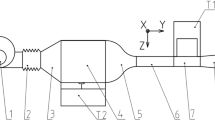Abstract
Momentum flux is a very important parameter for predicting the mixing potential of injection processes. Important factors such as spray penetration, spray cone angle, and air entrainment depend largely on spray momentum. In this article, a model is obtained which is able to predict the spray tip penetration using as an input the spray momentum flux signal. The model is based on the division of the momentum flux signal into momentum packets (fuel parcels) sequentially injected, and the tracking of them along the spray. These packets follow a theoretical equation which relates the penetration with the ambient density, momentum, spray cone angle and time. In order to validate the method, measures of momentum flux (impingement force) and macroscopic spray visualization in high density conditions have been performed on several mono-orifice nozzles. High agreement has been obtained between spray penetration prediction from momentum flux measurements and real spray penetration from macroscopic visualization.
Similar content being viewed by others
Abbreviations
- Din :
-
Inlet diameter of the nozzle’s orifices
- Dout :
-
Outlet diameter of the nozzle’s orifices
- k-factor:
-
Convergence or divergence factor
- M:
-
Momentum flux
- Pb:
-
Backpressure
- Pi:
-
Injection Pressure
- S:
-
Spray tip penetration
- T:
-
Time
- kp :
-
Penetration constant
- Si :
-
Packet penetration at the front of the spray
- Si′:
-
Packet penetration inside the spray
- toi :
-
Packet origin time
- tci :
-
Packet front reaching time
- Sci :
-
Packet front reaching penetration
- ρa :
-
Ambient density
- θ:
-
Spray cone angle
- ϕi :
-
Packet phase lag
References
Bermúdez, V., Payri, R., Salvador, F. J. and Plazas, A. H., 2005, “Study of the Influence of Nozzle Seat Type on Injection Rate and Spray Behavior,”Proc. ImechE, Vol. 219, part D: J. Automobile Engineering, pp. 677–689.
Dent, J. C., 1971, “A Basis for the Comparison of Various Experimental Methods for Studying Spray Penetration,”SAE Paper 710571.
Desantes, J. M., Payri, R., Salvador, F. J. and Gil, A., 2006, “Development and Validation of a Theoretical Model for Diesel Spray penetration,”Fuel 85, pp. 910–917.
Desantes, J. M., Payri, R., Garca, J. M. and Salvador, F. J., 2007, “A Contribution to the Understanding of Isothermal Diesel Spray Dynamics,”Fuel 86, pp. 1093–1101.
Flaig, U., Polach, W. and Ziegler, G., 1999, “Common Rail System for Passenger car DI Diesel Engines,” Experiences with Applications for Series Production Projects”. SAE Paper 1999-01-0191.
Kim, C. H. and Lee, J. S., 2003, “An Analytical Study on the Performance Analysis of a Unit-Injector System of a Diesel Engine,”KSME International Journal, Vol. 17, No. 1, pp. 146–156.
Koo, J. Y., 2003, “The Effects of Injector Nozzle Geometry and Operating Pressure Conditions on the Transient fuel spray Behavior,”KSME International Journal, Vol. 17, No. 3, pp. 617–625.
Macián, V., Bermúdez, V., Pyri, R. and Gimeno, J., 2003, “New Technique for the Determination of the Internal Geometry of Diesel Nozzles with the use of the Silicone Methodology,”Experimental Techniques, Vol. 27, No. 2, pp. 39–43.
Naber, J. and Siebers, D. L., 1996, “Effects of Gas Density and Vaporisation on Penetration and Dispersion of Diesel Sprays,”SAE Paper 960034.
Pastor, J.V., Arrègle, J., Palomares, A., 2001, “Diesel Spray Image Segmentation with a Likelihood Ratio Test,”Applied Optics, Vol. 40, No. 17, pp. 2876–2885.
Payri, R., Molina, S., Salvador, F. J. and Gimeno, J., 2004, “A Study of the Relation Between Nozzle Geometry, Internal Flow and Sprays Characteristics in Diesel Fuel Injection Systems,”KSME International Journal, Vol. 18, No. 7, pp. 1222–1235.
Payri, R., García, J. M., Salvador, F. J. and Gimeno, J., 2005a, “Using Spray Momentum Flux Measurements to Understand the Influence of Diesel Nozzle Geometry on Spray Characteristics,”Fuel 2005; 84: 551–561.
Payri, R., Salvador, F.J., Gimeno, J., Soare, V., 2005b, “Determination of Diesel Sprays Characteristics in Real Engine in-Cylinder Air Density and Pressure Conditions,”Journal of Mechanical Science and Technology, Vol. 19, No. 11, pp. 2040–2052.
Yeom, J. K., “A Study on the Behavior Characteristics of Diesel Spray by using a High Pressure Injection System with Common Rail Apparatus,”KSME International Journal, Vol. 17, No. 9, pp. 1371–1379.
Wakuri, Y., Fujii, M., Amitani, T. and Tsuneya, R., 1960, “Studies of the Penetration of a Fuel Spray in a Diesel Engine,”Bull. J.S.M.E. 3(9), pp. 123–130.
Author information
Authors and Affiliations
Corresponding author
Rights and permissions
About this article
Cite this article
Payri, R., Ruiz, S., Salvador, F.J. et al. On the dependence of spray momentum flux in spray penetration: Momentum flux packets penetration model. J Mech Sci Technol 21, 1100–1111 (2007). https://doi.org/10.1007/BF03027660
Received:
Revised:
Accepted:
Issue Date:
DOI: https://doi.org/10.1007/BF03027660




